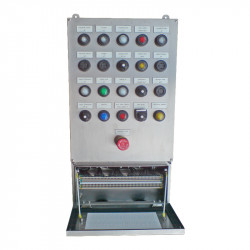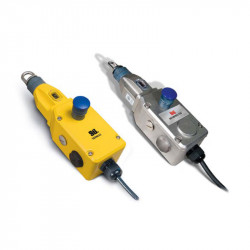-
BackX
-
Components
-
-
Category
-
Semiconductors
- Diodes
- Thyristors
-
Electro-insulated Modules
- Electro-insulated Modules | VISHAY (IR)
- Electro-insulated Modules | INFINEON (EUPEC)
- Electro-insulated Modules | Semikron
- Electro-insulated Modules | POWEREX
- Electro-insulated Modules | IXYS
- Electro-insulated Modules | POSEICO
- Electro-insulated Modules | ABB
- Electro-insulated Modules | TECHSEM
- Go to the subcategory
- Bridge Rectifiers
-
Transistors
- Transistors | GeneSiC
- SiC MOSFET Modules | Mitsubishi
- SiC MOSFET Modules | STARPOWER
- Module SiC MOSFET ABB’s
- IGBT Modules | MITSUBISHI
- Transistor Modules | MITSUBISHI
- MOSFET Modules | MITSUBISHI
- Transistor Modules | ABB
- IGBT Modules | POWEREX
- IGBT Modules | INFINEON (EUPEC)
- Silicon Carbide (SiC) semiconductor elements
- Go to the subcategory
- Gate Drivers
- Power Blocks
- Go to the subcategory
- Electrical Transducers
-
Passive components (capacitors, resistors, fuses, filters)
- Resistors
-
Fuses
- Miniature Fuses for electronic circuits - ABC & AGC Series
- Tubular Fast-acting Fuses
- Time-delay Fuse Links with GL/GG & AM characteristics
- Ultrafast Fuse Links
- Fast-acting Fuses (British & American standard)
- Fast-acting Fuses (European standard)
- Traction Fuses
- High-voltage Fuse Links
- Go to the subcategory
- Capacitors
- EMI Filters
- Supercapacitors
- Power surge protection
- TEMPEST emission revealing filters
- Surge arrester
- Go to the subcategory
-
Relays and Contactors
- Relays and Contactors - Theory
- 3-Phase AC Semiconductor Relays
- DC Semiconductor Relays
- Controllers, Control Systems and Accessories
- Soft Starters and Reversible Relays
- Electromechanical Relays
- Contactors
- Rotary Switches
-
Single-Phase AC Semiconductor Relays
- AC ONE PHASE RELAYS 1 series| D2425 | D2450
- One phase semiconductor AC relays CWA and CWD series
- One phase semiconductor AC relays CMRA and CMRD series
- One phase semiconductor AC relays - PS series
- Double and quadruple semiconductor AC relays - D24 D, TD24 Q, H12D48 D series
- One phase semiconductor relays - gn series
- Ckr series single phase solid state relays
- One phase AC semiconductor relays for DIN bus - ERDA I ERAA series
- 150A AC single phase relays
- Rail Mountable Solid State Relays With Integrated Heat Sink - ENDA, ERDA1 / ERAA1 series
- Go to the subcategory
- Single-Phase AC Semiconductor Relays for PCBs
- Interface Relays
- Go to the subcategory
- Cores and Other Inductive Components
- Heatsinks, Varistors, Thermal Protection
- Fans
- Air Conditioning, Accessories for Electrical Cabinets, Coolers
-
Batteries, Chargers, Buffer Power Supplies and Inverters
- Batteries, Chargers - Theoretical Description
- Modular Li-ion Battery Building Blocks, Custom Batteries, BMS
- Batteries
- Battery Chargers and Accessories
- Uninterruptible Power Supply and Buffer Power Supplies
- Inverters and Photovoltaic Equipments
- Energy storage
- Fuel cells
- Lithium-ion batteries
- Go to the subcategory
-
Automatics
- Spiralift Lifts
- Futaba Drone Parts
- Limit Switches, Microswitches
- Sensors, Transducers
-
Infrared Thermometers (Pyrometers)
- IR-TE Series - Water-proof Palm-sized Radiation Thermometer
- IR-TA Series - Handheld Type Radiation Thermometer
- IR-H Series - Handheld Type Radiation Thermometer
- IR-BA Series - High-speed Compact Radiation Thermometer
- IR-FA Series - Fiber Optic Radiation Thermometer
- IR-BZ Series - Compact Infrared Thermometers
- Go to the subcategory
- Counters, Time Relays, Panel Meters
- Industrial Protection Devices
- Light and Sound Signalling
- Thermographic Camera
- LED Displays
- Control Equipments
- Go to the subcategory
-
Cables, Litz wires, Conduits, Flexible connections
- Wires
- Cable feedthroughs and couplers
- Litz wires
-
Cables for extreme applications
- Extension and Compensation cables
- Thermocouple cables
- Connection cables for PT sensors
- Multi-conductor wires (temp. -60C to +1400C)
- Medium voltage cables
- Ignition wires
- Heating cables
- Single conductor cables (temp. -60C to +450C)
- Railway cables
- Heating cables Ex
- Cables for the defense industry
- Go to the subcategory
- Sleevings
-
Braids
- Flat Braids
- Round Braids
- Very Flexible Flat Braids
- Very Flexible Round Braids
- Cylindrical Cooper Braids
- Cylindrical Cooper Braids and Sleevings
- Flexible Earthing Connections
- PCV Insulated Copper Braids (temp. up to 85C)
- Flat Aluminium Braids
- Junction Set - Braids and Tubes
- Steel Braids
- Go to the subcategory
- Traction Equipment
- Cable Terminals
- Flexible Insulated Busbars
- Flexible Multilayer Busbars
- Cable Duct Systems
- Go to the subcategory
- View all categories
-
Semiconductors
-
-
- Suppliers
-
Applications
- CNC Machine Tools
- DC and AC Drives (Inverters)
- Energetics
- Energy bank
- Equipment and Components for Hazardous Areas [Ex]
- Equipment for Distribution, Control and Telecommunications Cabinets
- HVAC Automation
- Induction Heating
- Industrial Automation
- Industrial Protective Devices
- Machines for Drying and Wood Processing
- Machines for Thermoforming Plastics
- Mining, Metallurgy and Foundry
- Motors and Transformers
- Power Supplies (UPS) and Rectifier Systems
- Printing
- Temperature Measurement and Regulation
- Test and Laboratory Measurements
- Tram and Railway Traction
- Welding Machines
-
Assembly
-
-
Inductors
-
-
Induction devices
-
-
Service
-
- Contact
- Zobacz wszystkie kategorie
Flammability of grain – what factors influence flammability?

Industrial process safety covers both occupational safety for employees and the safety of technological processes being carried out.
Both of these areas together form overall safety in a production plant, which, according to applicable legal regulations, must be ensured. Process safety, which is an integral part of overall safety, specifically refers to process installations that contain and process chemical substances. It therefore concerns issues related to the design and operation of installations in which various chemical and physical processes occur involving the processing of chemical substances (unit operations) into useful final products, focusing on preventing unwanted releases of mixtures and/or energy, as well as mitigating the effects of such releases. Awareness of maintaining process safety accompanies the design of every chemical or refinery installation at all stages of its development. This also includes facilities for storing and processing solid substances. It is part of every process project, which is the main product of process engineering.
Explosion hazard zones in the food industry
The food industry is a specific group of industrial plants that have solid substances such as grains, sugar, tea, coffee, corn, etc., on their premises. This specificity lies in the fact that dust hazard analysis differs from gas analysis and that other additional parameters are taken into account in the risk assessment process. In the case of grain-based products, the presence of grain and flour dust is a factor creating a high level of fire and explosion hazard. It is worth noting that Poland is one of the largest grain producers in Europe and one of the largest in the world. According to GUS data for 2018, annual grain production in Poland amounts to approximately 27 million tons, including about 10 million tons of wheat and 4 million tons of triticale. This makes the probability of failure during the processes it undergoes higher than in most other countries. During the technological processes of grain reception, cleaning, drying, and preservation, as well as grain milling into flour, local dust contaminants known as technological dust are generated. They are produced as a result of grains rubbing against each other and against machine components inside the equipment. Dusts thus rise inside devices during horizontal and vertical transport, in cleaning machines and equipment, drying and grinding grain, as well as sieving, sorting, and packing of crushed semi-finished and finished products.
Research shows that nearly 25% of all dust explosions occur in the agri-food and feed industries, with silos, dedusting systems, and ventilation systems – including dryers and grain storage facilities – being the most prone to explosions.
Physicochemical quantities
According to accepted practice, every flammable/explosive dust should be tested in a facility equipped with an appropriate laboratory or by using available safety data sheets for the specific substance. Among the many quantities describing their physicochemical properties, several parameters are distinguished:
Pmax [bar] – the maximum explosion pressure measured during the explosion of a dust-air mixture in the closed volume of the test sphere (explosive atmosphere). The value of this parameter depends on the initial pressure.
(dp/dt)max [bar/s] – the maximum rate of pressure rise of the explosive atmosphere over time. This parameter defines the “dynamics” of the explosion process of a given dust and forms the basis for determining the next parameter, Kst.
Kst [m * bar/s] – the dust constant, known as the explosibility index, serves as the basis for the international classification of dust explosibility (see the table below).
DGW [g/m3] – lower explosion limit. This refers to the lowest concentration of fuel (in this case, dust) with air (in the test sphere) at which an explosion occurs. Below this value, the combustible mixture is too lean in fuel and contains too much oxidizer to initiate an explosion.
GST [%] – limiting oxygen concentration, the maximum oxygen concentration in a mixture of combustible dust with air and an inert gas at which no explosion occurs.
MEZ [mJ] – minimum ignition energy of the dust-air mixture, i.e., the minimum energy of a spark discharge (of a specified value) between two electrodes that will ignite the dust-air mixture.
MTZw [°C] – minimum layer ignition temperature, i.e., the minimum temperature of a hot plate on which a 5 mm layer of dust will ignite.
MTZo [°C] – minimum temperature at which a dust cloud ignites in a furnace with known wall and atmosphere temperatures.
|
Hazard class |
Kst [m * bar/s] |
Type of hazard |
|
ST0 |
0 |
Non-explosive dust |
|
ST1 |
1 – 200 |
Weakly explosive dust |
|
ST2 |
201 - 300 |
Strongly explosive dust |
|
ST3 |
>300 |
Very strongly explosive dust |
Factors affecting explosibility parameters
Many factors can influence the explosibility parameters of dust:
- Chemical composition of dust particles (different elements and compounds burn in different ways);
- Particle size (explosibility parameters usually vary depending on dust grain size – smaller particles burn faster, increasing explosibility parameters as particle size decreases);
- Moisture content (high moisture content in dust hinders its combustion);
- Dust concentration (determines the amount of combustible material in the dust-air mixture);
- Oxygen concentration (a certain oxygen threshold is necessary to initiate combustion – with too little oxygen, combustion cannot begin);
The physical properties of cereal grains are closely related to their chemical structure and have a significant impact on the biological processes of the stored grain mass. The most important biological process of grain is respiration. The grain absorbs oxygen from the air, oxidizes chemical substances, and releases carbon dioxide and water. As a result, heat is generated, intensifying grain respiration and increasing its temperature, which depends largely on its moisture content. When both humidity and temperature increase with access to oxygen, the grain swells and tends to self-heat and eventually self-ignite. The most prone to self-heating are immature, freshly harvested, sprouted, and heavily contaminated grains. Self-ignition is also promoted by sorting, one of the characteristic processes for this material. This results from the flowability and heterogeneity of the grain mass in storage. It occurs during pouring and conveying grain but most often during filling and emptying storage chambers. The contents of the chamber become nonuniform: coarser and cleaner grains accumulate in the center, while finer and more contaminated grains settle toward the walls. At high humidity, this is where the likelihood of spontaneous ignition is greatest.
Other properties of grain include hygroscopicity, thermal conductivity, and dust emission during all technological operations. Hygroscopicity means absorbing or releasing moisture depending on the humidity of the environment. In such areas, the risk of self-ignition is higher. Grain is a poor conductor of heat, ignites at around 450°C, has a heat value of 3.5–4.0 Mcal/kg, and burns without flame, glowing.
There are many types of installations involved in storing and processing grain, so a single standard cannot be defined. However, based on a bakery-confectionery plant for which DACPOL prepared an explosion risk assessment document, certain characteristic sections of the technological line can be identified.
Types of installations by functionality
An example installation can be divided, by functionality, into the following parts:
- used for pneumatic transport of grain during silo loading,
- intended for storing grain in external silos,
- used for screw transport of grain during silo unloading,
- used for preparing grain for milling through mechanical cleaning and moistening,
- including a mill for grain grinding with its equipment,
- an internal integrated flour storage system consisting of four silos with accessories and a pneumatic system for flour transport and dosing at dough preparation stations.
Elements that may pose an explosion hazard
Based on adopted analytical methods, operations are carried out to determine which elements may pose an explosion hazard, its scale, and potential consequences. Considering the example structure of the plant mentioned above, at least a dozen potentially hazardous areas and elements can be identified. The following types of equipment and factors that may cause failure, and consequently fire or explosion, should be highlighted:
1. Screw conveyors, chain conveyors ("rodlers"):
- shaft misalignment, blade friction against the housing, chain breakage, link friction, entry of metal objects,
- heating and ignition of dust.
2. Bucket elevators:
Belt seizure, belt and dust ignition may occur for the following reasons:
- blockage formation,
- bucket catching on housing,
- clogging due to foreign objects entering the boot section,
- excessive belt slack,
- bearing seizure due to insufficient lubrication.
3. Dehullers, sorting machines for husk processing:
There is a risk of dust ignition or explosion if:
- a metal object enters the drum,
- sparking caused by loosening of the beater or brush mounts due to friction,
- sandpaper or metal drum surfaces,
- sparking from a chipped abrasive mass fragment,
- bearing overheating.
4. Grinding devices, roller mills, bran throwers:
Ignition or explosion of dust may occur if a metal object enters the device and sparks or heats due to friction.
5. Pneumatic transport:
In pneumatic transport equipment and ducts, as well as feeding devices (cyclones), explosive dust concentrations occur, and collisions between particles cause static electricity buildup. Explosion or fire may result from:
- static electricity discharge,
- sparking caused by fan blade friction against the housing,
- fan bearing overheating.
6. Aspiration systems:
There is a risk of ignition of grain or flour dust in case of:
- a fire source arising in one of the above-mentioned devices,
- sparking caused by fan blade friction,
- fan bearing seizure.
7. During loading of grain and flour chambers:
The hazard exists due to the presence of open flames or dust ignition from faulty electrical equipment.
Stages of explosion risk assessment analysis
Analyses forming the basis for explosion risk assessment are carried out in stages. In the first stage, identification and verification of data concerning the execution of tasks and processes in the relevant areas are performed. The work is based on documentation provided by the Client, containing technological characteristics of installations and facilities, as well as physicochemical specifications including ignition and explosion parameters of flammable substances used. Supplementation and verification of documentation data come from information obtained during on-site inspections.
Based on the collected information and process data, an identification analysis of explosion hazards is conducted, including:
- identification of flammable substances,
- identification of potential explosive atmosphere locations,
- identification and classification of emission sources of flammable substances, and
- determination of the probability of explosive atmosphere occurrence.
The results of explosion hazard identification analyses are used to determine the classification of explosion hazard zones. The full classification documentation is supplemented with graphic documentation, including layout plans showing the type and range of explosion hazard zones as well as the location and identification of emission sources, in accordance with Polish Standards. In all areas where explosion hazard zones are classified, the category of equipment (marking according to the directive, not the standard) permitted for use is determined, enabling the selection of appropriate components and machines with ATEX certification.
Related products
Related posts
 Now available – DC/DC converters from PREMIUM
Now available – DC/DC converters from PREMIUM
 New release in DACPOL lighting for lathes – Kira covers
New release in DACPOL lighting for lathes – Kira covers













Leave a comment